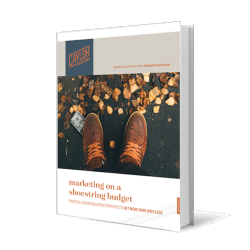Faith-Based Enrollment Marketing: Strategies That Reflect Your Mission
Discover faith-based enrollment marketing strategies that align with your mission and attract students who thrive in your Christian college environment.
Featured
It’s hard to imagine a more relevant conversation for higher education than the evolving relationship between digital natives and AI.
This makes a lot of sense because Gen Z students are growing up immersed in a world shaped by algorithms, automation, and machine learning.
They’ve grown up with smartphones in their pockets, Alexa answering their questions, and AI tools like ChatGPT doing everything from summarizing articles to brainstorming essays.
They’re not just tech-savvy… they’re digital natives, fluent in AI-driven technology, personalization, and digital environments.
And while higher education has made strides in digital transformation, many institutions are still struggling with a critical question:
 In this episode of The Higher Ed Marketer, Troy and I sat down with Conor Grennan, Chief AI Architect at NYU Stern School of Business, and his 16-year-old son, Finn, a high school student and digital native himself.
In this episode of The Higher Ed Marketer, Troy and I sat down with Conor Grennan, Chief AI Architect at NYU Stern School of Business, and his 16-year-old son, Finn, a high school student and digital native himself.
Their father-son perspective revealed something powerful.
If higher ed wants to connect with this new generation, we need to rethink not just how we teach AI, but also how we talk about the relationship between digital natives and AI.
From the outside, it may seem like Gen Z embraces AI tools without much thought.
But Finn offered a different picture.
“When teachers tell us not to use AI, it just doesn’t feel like they understand how much we’re using it already and why. Sometimes it’s just to brainstorm or get unstuck. It’s not about cheating. It’s about making the process faster or better.”
This insight is huge.
Students like Finn aren’t asking, “Is this ethical?” every time they use ChatGPT. They’re asking, “Does this help?”
For higher ed leaders, this means the usual warnings about academic integrity may fall flat or, worse, be ignored.
Conor added that this disconnect can actually harm trust.
“When students feel like we’re just saying, ‘Don’t cheat,’ they shut down.
But when we say, ‘Here’s what this tool is capable of, here’s what you can do with it, and here’s how to use it responsibly,’ they light up.”
That’s the first big takeaway.
If we want to build AI literacy in digital natives, we must speak their language — one of curiosity, not control.
Conor, who works with top organizations and institutions through his company AI Mindset, explained that teaching AI isn’t just about explaining how it works.

It’s about encouraging behavioral shifts and a new way of engaging with technology and information.
“We’re not trying to teach prompt engineering or get into the technical weeds.
We’re teaching people how to think differently, how to collaborate with AI, how to reflect on its outputs, and how to take ownership of their choices with these tools.”
Rather than positioning AI as a threat to academic integrity, Conor encourages us to position it as an opportunity for critical thinking, ethical reasoning, and creativity.
It’s a shift from “command-and-control” policies to collaborative exploration.
And it’s exactly what resonates when talking about digital natives and AI.
Throughout the episode, a theme kept resurfacing: trust.
Students like Finn want to be trusted.
They want educators to believe that they’re capable of using AI responsibly… if they’re shown how.
When teachers give us space to talk about AI, it makes it feel less scary. I think we’d use it better if we had more conversations about it, not fewer.
This is a valuable challenge to higher ed.
A: Trust begins by creating open conversations about AI rather than enforcing restrictive policies. Schools that involve students in shaping how AI is used — while modeling transparent, values-based engagement — are more likely to foster responsible and confident use among digital natives.
AI literacy isn’t just a compliance issue.
It’s a cultural one.
Educators must be empowered to lead honest, nuanced conversations about AI that do not start with fear, but with curiosity.
That means equipping faculty with not just tools, but frameworks.
Conor’s work at NYU Stern focuses exactly on that.
He gives faculty and staff the behavioral models and confidence to talk about AI meaningfully.
He’s trained thousands through his AI Mindset methodology, and the results are transformative.
There’s something deeply powerful about hearing a high school student reflect on AI.
Finn isn’t just another “techie teen.”
He represents an entire generation navigating a digital world without a map.
Yet his insight is sharp, and his sense of ethics is stronger than many adults give credit for.
I think we’re still figuring it out. But if schools showed us how to use AI in ways that are actually helpful, that would stick with us. I’d want to know what’s possible, not just what’s forbidden.
That line struck me.
A: The most effective approach is to shift from fear-based messaging to AI fluency by encouraging exploration, critical thinking, and ethical collaboration with tools like ChatGPT. Universities should frame AI as a literacy, not a liability, and include hands-on training and real-world applications.
That’s where higher ed has the opportunity to lead.
Rather than doubling down on what they cannot do, we can start pointing toward what digital natives and AI can do together.
In other words, AI can be a partner in learning rather than a tool to avoid.
Based on this episode, here are four practical takeaways for higher ed marketers, faculty, and leaders:
AI isn’t going away and digital natives are already using it.
Instead of warning against it, offer guidance on how to engage with it meaningfully.
Frame the use of generative AI as a point of literacy instead of a liability.

Students don’t just want to be told how to use AI. They want to be part of shaping the conversation.
Create spaces where they can ask questions, share perspectives, and help define what responsible use looks like.
Educators need more than technical know-how.
They need language, models, and permission to have human conversations about AI.
Equip them with tools like Conor’s AI Mindset approach to make this easier.
A: As digital natives arrive on campus already using AI tools, it’s critical that faculty and staff feel equipped to guide them. Professional development programs like AI Masterclasses help institutions reframe AI as an opportunity for collaboration and innovation rather than simply a threat to academic integrity.
Rules without relationship breed rebellion.
But when students feel respected and trusted, they’re more likely to engage thoughtfully.
Build that trust by showing you’re open to listening and learning, just like they are.
At the end of our conversation, I asked Conor what he hopes higher ed will take away from this moment in time.
His answer was simple and profound.
AI is not just a tool. It’s a mirror. It reflects how we teach, how we trust, how we learn. If we can meet this moment with empathy and openness, we’re going to raise a generation of students who are not only literate in AI but also human in all the best ways.
This episode reminded me that AI is not the story.
Students are.
And if we truly want to serve them well, we need to stop talking past them and start learning alongside them.
Because in the end, AI may shape the world — but it’s digital natives like Finn who will shape how we use it.
🎧 For even more insights from Conor and Finn Grennan, listen to the full episode on The Higher Ed Marketer podcast.
Empower Your Team to Lead the Next Generation of Digital Natives and AI
Today’s students are growing up with AI.
Are your teams ready to lead them?
Caylor Solutions’ Custom AI Masterclass is a hands-on training experience designed to equip your staff with the confidence, tools, and frameworks to harness AI.
More than a productivity booster, it is a bridge to connect more deeply with digital natives.
This immersive 6-hour workshop is perfect for enrollment marketers, communicators, faculty, and institutional leaders who want to go beyond the fear and fully embrace AI fluency.
Whether you’re looking to streamline your processes, personalize student communications, or simply start having better conversations about AI on campus, this Masterclass will move your team from hesitant to confident.
Your students are already using AI.
Let’s make sure your team is, too.
👉 Learn More or Schedule Your AI Masterclass
Set yourself free from your shrinking marketing budget with my popular ebook Marketing on a Shoestring Budget! This ebook is jammed with practical ways to produce high-quality marketing on the cheap.
Inside, I’ll show you proven marketing tactics like…
No hype. No pie in the sky. Just real solutions for getting the job done with the budget you’ve got.
Featured image via stern.nyu.edu
Subscribe to The Higher Ed Marketer podcast today!